Unicellular algae X and Y of the same species were taken and chloroplasts were removed from cell X. After some time, they both were kept in bright sunlight for few hours and then iodine test was performed on them. What will be the results?
Both X and Y will turn blue-black.
Cell X will turn blue-black.
Cell Y will turn blue-black.
Both X and Y will remain as they originally were.
The correct Answer is:C
Step-by-Step Solution:
1. Understanding the Organisms: We have two unicellular algae, X and Y, which belong to the same species. Algae are capable of photosynthesis, which requires chloroplasts containing chlorophyll.
2. Chloroplast Removal: In this scenario, chloroplasts are removed from algae X. This means that algae X will not be able to perform photosynthesis, as chloroplasts are essential for this process.
3. Exposure to Sunlight: Both algae X and Y are kept in bright sunlight for a few hours. Algae Y, which still has its chloroplasts, will undergo photosynthesis and produce starch as a byproduct.
4. Iodine Test: After the exposure to sunlight, an iodine test is performed on both algae. The iodine test is used to detect the presence of starch. If starch is present, the iodine will turn blue-black.
5. Results for Algae X: Since algae X does not have chloroplasts, it cannot perform photosynthesis and therefore will not produce any starch. As a result, when iodine is applied, there will be no color change in algae X.
6. Results for Algae Y: Algae Y, on the other hand, has intact chloroplasts and can perform photosynthesis. It will produce starch, and when iodine is applied, it will turn blue-black due to the presence of starch.
7. Conclusion: The results of the iodine test will show that algae X remains unchanged (no color change), while algae Y turns blue-black.
Final Results:
- Algae X: No color change (remains original color)
- Algae Y: Turns blue-black
---
- Algae X: No color change (remains original color)
- Algae Y: Turns blue-black
Topper's Solved these Questions
- CELL - THE FUNDAMENTAL UNIT OF LIFE BOOK - SCIENCE OLYMPIAD FOUNDATION CHAPTER - CELL - THE FUNDAMENTAL UNIT OF LIFE EXERCISE - MULTIPLE CHOICE QUESTIONS (ACHIEVERS SECTION (HOTS))
5 Videos
- CLASS 9 SAMPLE PAPER FINAL 4BOOK - SCIENCE OLYMPIAD FOUNDATION CHAPTER - CLASS 9 SAMPLE PAPER FINAL 4EXERCISE - SCIENCE
2 Videos
Similar Questions
A student was–performing an activity to prove the requirements for photosynthesis. During this activity, he kept two identical healthy potted plantsA and Bin dark for 72 hours. After 72 hours, he covered plant A and B by bell shaped jars separately. While covering the plants with separate bell jars, he kept KOH in the watch glass by the side of the plant in setup A and not in setup B. Both these setups were made air tight and were kept in light for 6 hours. Then, Iodine Test was performed with one leaf from each of the two plants A and B.
Which of the following statements shows the correct results of Iodine Test performed on the leaf from plant A and B respectively?
View SolutionA student was–performing an activity to prove the requirements for photosynthesis. During this activity, he kept two identical healthy potted plantsA and Bin dark for 72 hours. After 72 hours, he covered plant A and B by bell shaped jars separately. While covering the plants with separate bell jars, he kept KOH in the watch glass by the side of the plant in setup A and not in setup B. Both these setups were made air tight and were kept in light for 6 hours. Then, Iodine Test was performed with one leaf from each of the two plants A and B.
The function of KOH is to absorb
View Solution
Knowledge Check
Case : The Figure shown below represents an activity to prove the requirements for photosynthesis. During this activity, two healthy potted plants were kept in the dark for 72 hours. After 72 hours, KOH is kept in the watch glass in setup X and 'not in setup Y. Both these setups are air tight and have been kept in light for 6 hours. Then, lodine Test is performed with one leaf from each of the two plants X and Y.
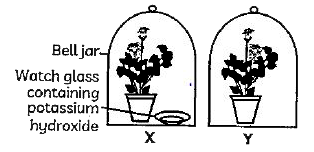
Which of the following statements shows the correct results of lodine Test performed on the leaf from plant X and Y respectively?ABlue - black colour would be obtained on the leaf of plant X and no change in colour on leaf of plant Y.BBlue - black colour would be obtained on the leaf of plant Y and no change in colour on leaf of plant X.CRed colour would be obtained on the leaf of plant X and brown colour on the leaf of plant Y.DRed colour would be obtained on the leaf of plant Y and brown colour on the leaf of plant X.Case : The Figure shown below represents an activity to prove the requirements for photosynthesis. During this activity, two healthy potted plants were kept in the dark for 72 hours. After 72 hours, KOH is kept in the watch glass in setup X and 'not in setup Y. Both these setups are air tight and have been kept in light for 6 hours. Then, lodine Test is performed with one leaf from each of the two plants X and Y.
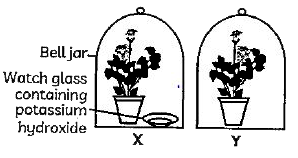
The function of KOH is to absorb :AOxygenBCarbon dioxideCMoistureDSunlightCase : The Figure shown below represents an activity to prove the requirements for photosynthesis. During this activity, two healthy potted plants were kept in the dark for 72 hours. After 72 hours, KOH is kept in the watch glass in setup X and 'not in setup Y. Both these setups are air tight and have been kept in light for 6 hours. Then, lodine Test is performed with one leaf from each of the two plants X and Y.
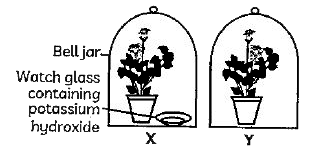
This experimental set up is used to prove essentiality of which of the following requirements of photosynthesis?AChlorophyllBOxygenCCarbon dioxideDSunlight
A student was–performing an activity to prove the requirements for photosynthesis. During this activity, he kept two identical healthy potted plantsA and Bin dark for 72 hours. After 72 hours, he covered plant A and B by bell shaped jars separately. While covering the plants with separate bell jars, he kept KOH in the watch glass by the side of the plant in setup A and not in setup B. Both these setups were made air tight and were kept in light for 6 hours. Then, Iodine Test was performed with one leaf from each of the two plants A and B.
This experimental set up is used to prove essentiality of which of the following requirements of photosynthesis?
View SolutionA student was–performing an activity to prove the requirements for photosynthesis. During this activity, he kept two identical healthy potted plantsA and Bin dark for 72 hours. After 72 hours, he covered plant A and B by bell shaped jars separately. While covering the plants with separate bell jars, he kept KOH in the watch glass by the side of the plant in setup A and not in setup B. Both these setups were made air tight and were kept in light for 6 hours. Then, Iodine Test was performed with one leaf from each of the two plants A and B.
Which of the following steps can be followed for making the apparatus air tight?
i. placing the plants on glass plate
ii. using a suction pump.
iii. applying Vaseline to seal the bottom of jar.
iv. creating vacuum
View SolutionThe Figure shown below represents an activity to prove the requirements for photosynthesis. During this activity, two healthy potted plants were kept in the dark for 72 hours. After 72 hours, KOH is kept in the watch glass in setup X and not in setup Y. Both these setups are air tight and have been kept in light for 6 hours. Then, Iodine Test is performed with one leaf from each of the two plants X and Y.
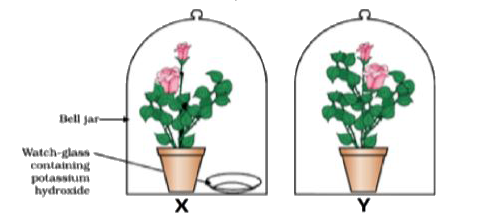
Which of the following statements shows the correct results of Iodine Test performed on the leaf from plant X and Y respectively?
View SolutionThe Figure shown below represents an activity to prove the requirements for photosynthesis. During this activity, two healthy potted plants were kept in the dark for 72 hours. After 72 hours, KOH is kept in the watch glass in setup X and not in setup Y. Both these setups are air tight and have been kept in light for 6 hours. Then, Iodine Test is performed with one leaf from each of the two plants X and Y.
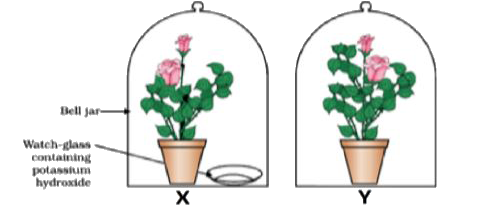
This experimental set up is used to prove essentiality of which of the following requirements of photosynthesis?
View SolutionThe Figure shown below represents an activity to prove the requirements for photosynthesis. During this activity, two healthy potted plants were kept in the dark for 72 hours. After 72 hours, KOH is kept in the watch glass in setup X and not in setup Y. Both these setups are air tight and have been kept in light for 6 hours. Then, Iodine Test is performed with one leaf from each of the two plants X and Y.
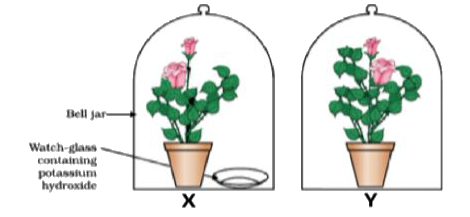
The function of KOH is to absorb
View Solution
